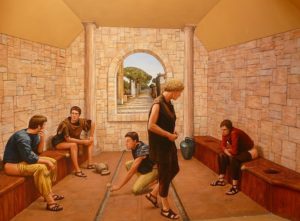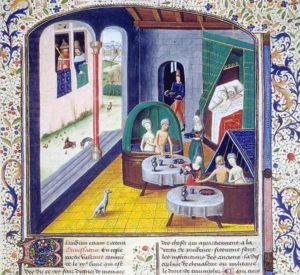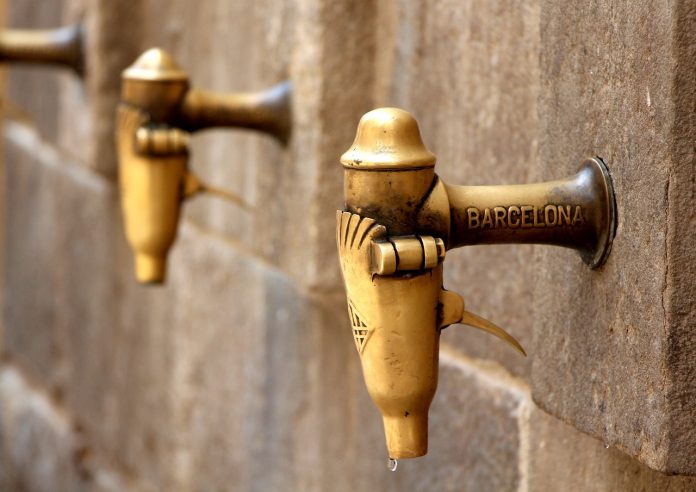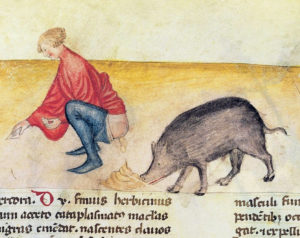Barcelona has almost 2000 years of special connection with neatness and human feces.
There are a lot of peculiar histories, but one of my favourites is the history of hygiene and cleaning services of Barcelona.
The neatness of the old town has been a matter of controversy for centuries. From Roman baths, through scarcity of hygiene of Christians in the medieval times, to the business of fecal waste pickers, stinking streams and bad chemistry with the modern water closets. But let’s start from the beginning…
Mens sana in corpore sano, “a healthy mind in a healthy body”
The city of Barcelona was called Barcino in Roman times. Barcino as other cities in the Roman Empire was famous for taking care of the personal hygiene of its citizens. Romans understood the connection between hygiene and health. “A healthy mind in a healthy body” was a widely used expression in those days.
Inside the bath houses, citizens got cleaned and people could receive cosmetic treatments with natural ingredients. Public baths and toilets became also an indispensable space in social life. In these beautifully decorated and comfortable places, even ordinary Romans could meet with higher members of society and do business or plot political conspiracies together.
In Barcino there was at least three public baths. The only one which still remains, is hidden in the basement of Barcelona City History Museum at the Plaça del Rei. The Romans also built a sewerage network that evacuated the fecal waste to the sea. Link
But still, public toilets and baths in Barcino wouldn’t have passed our modern standards of hygiene. Bath houses and people’s clothes were cleaned with urine. In the absence of toilet paper, the butts cleaning device was a wooden stick with a sea sponge attached at one of the ends. Usually, the sponges were also public. Only the wealthier citizens carried their own.
Muslims, Jews and Christians during the “Dark Ages”
In the early medieval times, after the fall of Rome, the sewer system disappeared. But, people still used to clean themselves with warm water inside the barrel saunas or baths. Public bath houses were popular throughout medieval Europe. Link
The public bath houses raised also controversy. Some people, especially the clergy, objected to the fact that men and women could meet and spent time with each other naked. It could lead to illicit sex… and it sure did. It seems to have been widely accepted that a bathhouse was not only a place to get just clean and healthy, but where you could spent time with prostitutes and have sex. (Maybe because of this medieval tradition, many of the brothels in Barcelona are still disguised as saunas).
The medieval times divided Barcelona and its inhabitants according to three religious communities – Christians, Jews and Muslims – and the conceptions of the human body and water that each faith promulgated.
Muslims were the cleanest
The cleanest, in terms of body hygiene, were the Muslims. Water was a purifying element. The believers had to clean themselves before each prayer.
The Jews in Barcelona used purifying baths, the ‘miqvé’. A believer had to submerge inside a special bath completely at certain times of the year. There can be found documentation that the Count of Barcelona Ramon Berenguer IV ordered to build new public baths for the city. The Jewish master Abraham Bonastruc built them in 1160. He requested in return a space reserved for the Hebrews. The ruins of his work were preserved until 1716. Still today, the street called Banys Nous, reminds us where these baths were located.
The Christians were the dirtiest residents. According to the extreme Christian beliefs at that time, the body was a prison of the soul. To clean it and taking care of it was considered sinful: “The more mortified and neglected the body was, the closer you became with the God. ”That’s why many extreme religious Christians committed self-inflicted tortures, especially during processions.
The human body waste accumulated in pits called ‘black holes’ inside the houses. People also released their urine from their windows to the streets.
The Modern Age and the “shittiest” job in the City
In the summer of 1854, the government gave in to public pressure and allowed Barcelona’s city walls to be torn down. With the extra space, the district of Eixample was born. The new city extension would become an efficient and livable place, unlike the congested, epidemic-prone old town within the walls. Also, a new complex sewage network was build, although not for all types of waste. The brand new sewer evacuated all liquids from the houses and rainwater from the streets, but human excrement was stored inside the domestic wells, as during the medieval times.
During the early early industrial era, the trade of human excrements had become a big business in Barcelona. The ever-growing number of citizens meant more clients for the fecal waste pickers and their contractors. The designer of Eixample, Ildefons Cerdà i Sunyer, even thought that the entire new extension of Barcelona could be built with help of money earned from the human excrements.
A marketplace of shit
Shit was valuable and farmers used it as natural fertiliser. The peasants bought it from Barcelona hundreds of tonnes every year. Even the Plaça Catalunya was originally designed as a huge marketplace of shit. In the end, it was maybe the upcoming 1888 Barcelona Universal Exposition that made the Catalan politicians feeling embarrassed and to change their original “crappy” idea.
The professionals who evaluated and collected the excrements were called Master Well Cleaners “Poceros”. They wore traditional Catalan clothes with a red cap (the barretina). Like the Caganer “the Crapper”, the popular figurine in Catalonia. He is always hiding with his pants down somewhere in the Nativity Scenes (el pessebre) during Christmas holidays.
Traditionally these Masters went knocking from door to door, ‘bought’ and extracted the dung from the dead wells, only to resell it to the peasants. The price was fixed according to the ‘quality’ of the material collected. The professionals poked the excrements with a stick and made quality checks by tasting it.
There has been a lot of debate in Catalonia of the true origin of the Caganer. In my opinion the popular figurine is a tribute to the professional tasters and all the wealth they created for the Catalan society. The tradition started and got popular at the peak of the excrement business. The Poceros also played an important part in the building of modern Barcelona and helped the farmers to harvest prosperous crops in the countryside.
Income flushed down the drain
 Fortunately, the business died little by little when the first artificial fertilisers and the ceramic toilets came out on the market. But still, some residents, especially the less fortunate ones, were manifesting against this technological revolution. Some, because they lost their profession. Others, because they lost their “natural” income.
Fortunately, the business died little by little when the first artificial fertilisers and the ceramic toilets came out on the market. But still, some residents, especially the less fortunate ones, were manifesting against this technological revolution. Some, because they lost their profession. Others, because they lost their “natural” income.
People also did not “trust” the water closets. Especially in the early years, accidents of gas made some of these precious toilet seats to explode, because of bad design and accumulation of methane. The “stingiest” couldn’t understand why somebody would be willing to flush their precious material “down the drain” and give up even more money to by a water closet.
In the beginning of the 20th century Barcelona the safety of toilets raised still polemic and worries in Barcelona. According to the newspaper Actualidad, on January 24, 1914, in the calle Pelai number 7, a Water Closet exploded and three people got injured. Link
If you are interested to find out more about the subject check out the studies from historian Dani Cortijo.





